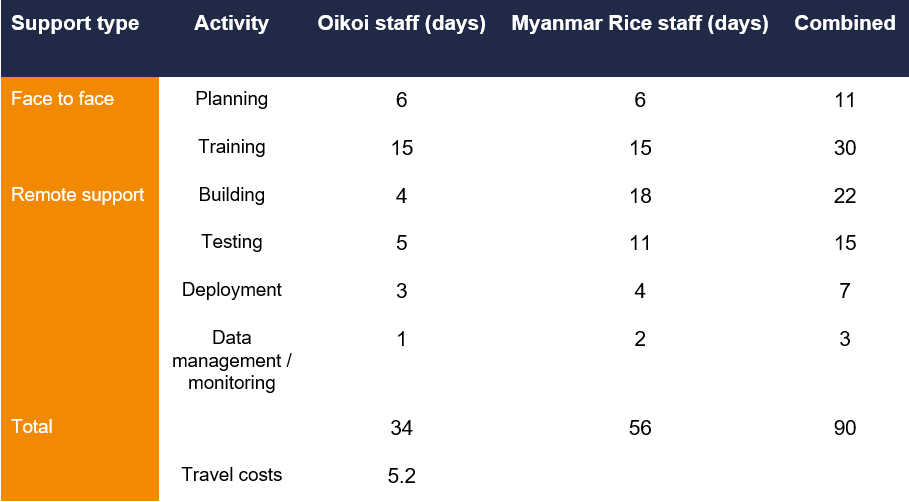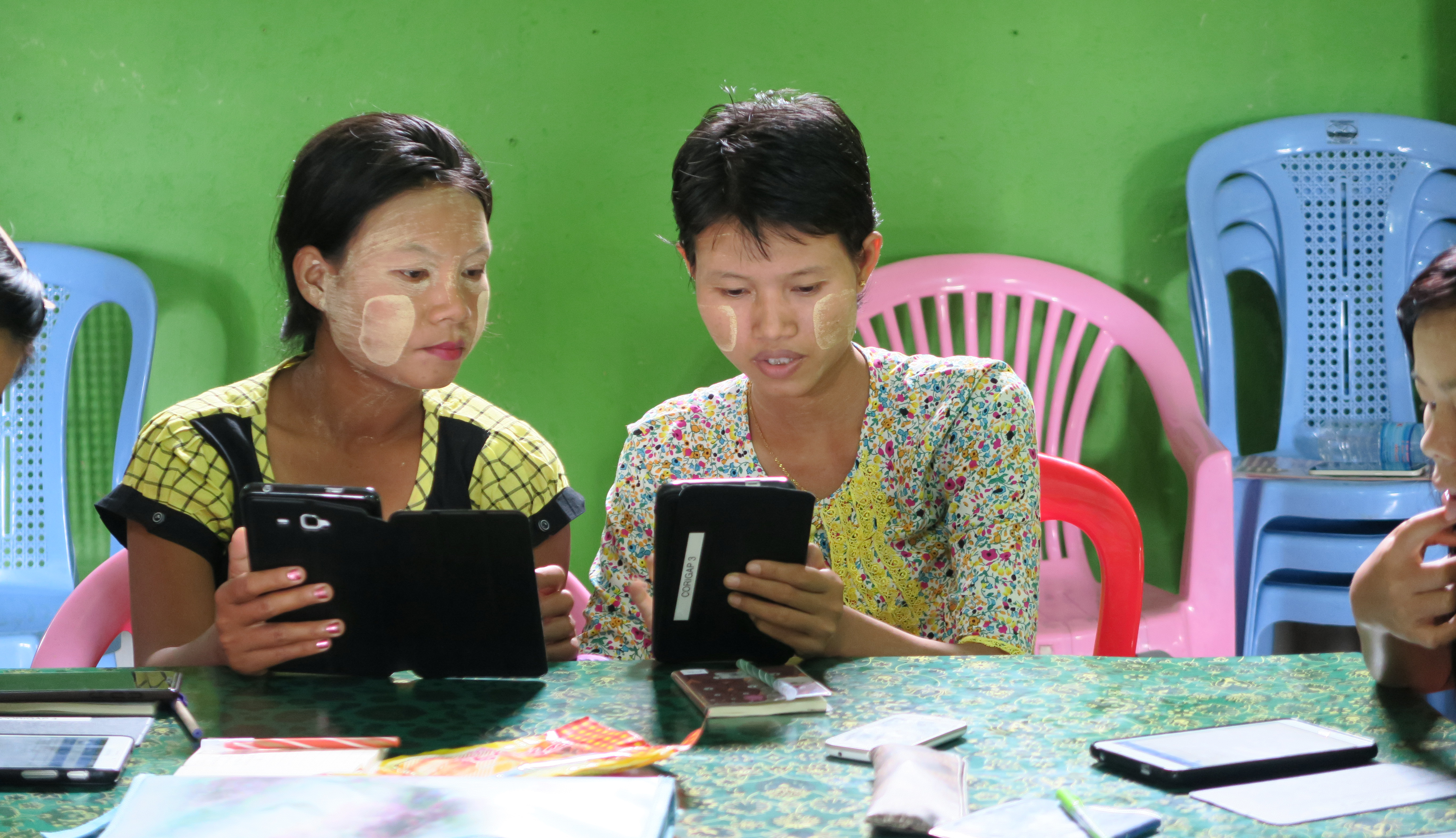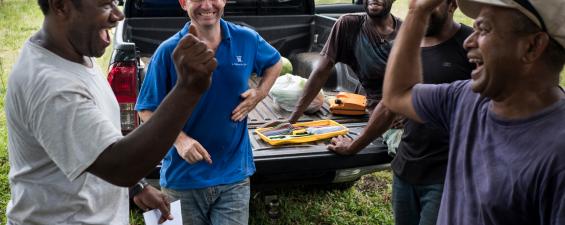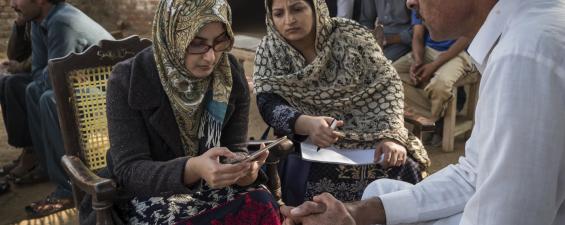Research Activities
The Myanmar Rice (MyRice) project aimed to improve farmer profitability through developing best practices for rice production, including post-harvest management. The project also aimed to develop innovative approaches to make rice-pulse cropping systems more productive. The project was managed by Dr Grant Singleton with MAD activities coordinated by Ms Arelene Malabayabas. The project included a needs assessment conducted in 16 villages. Baseline household surveys were conducted with 25 households in 8 villages (n = 200). Farmer practice and performance in summer rice cropping was assessed to establish local best practice (i.e. alternate wet and dryings, nutrient management, herbicide use, direct seeding). Weeds in summer pulse systems were also monitored for their impact on production. On-farm field trials were established at 8 sites in each participating township. Agronomic and varietal selection trials were run throughout the project at these sites. A postharvest loss assessment trial was also conducted. Finally, postharvest management training was provided to local extension officers, NGO staff, farmers, rice millers and research staff.
More information about the overall project can be found on the ACIAR website.
Initial Perceptions
The team in the MyRice project had previously conducted research using digital data collection platforms SurveyBe and CSPro. With SurveyBe, the team were able to develop the application themselves. However, they found the platform expensive, prone to crashing and the data format was difficult to work with for analysis. CSPro application development was previously completed by a consultant programmer because the research group did not have the required skills. Outsourcing to a consultant made changes a time-consuming and expensive process, and the researchers were not satisfied with the final product.
The MyRice project leader Dr Grant Singleton already had substantial experience with MAD, and a comprehensive understanding of the benefits and issues that could be expected. He was most interested in the immediacy of feedback to smallholders and the validation features available in mobile applications. His initial concerns were around how quickly the applications could be built and whether they would be easy for enumerators to use in the field. He was also keen to avoid excessive data collection, and concerned around data ethics and use, as well as language barriers and internet connectivity. One benefit he hoped to see specifically from the MyRice team's involvement in the MAD SRA was the beginning of a consistency in data collection format across multiple IRRI projects. App manager Su Su San had similar concerns to Dr Singleton, but was additional wary of the potential costs to the project from adopting MAD technologies.
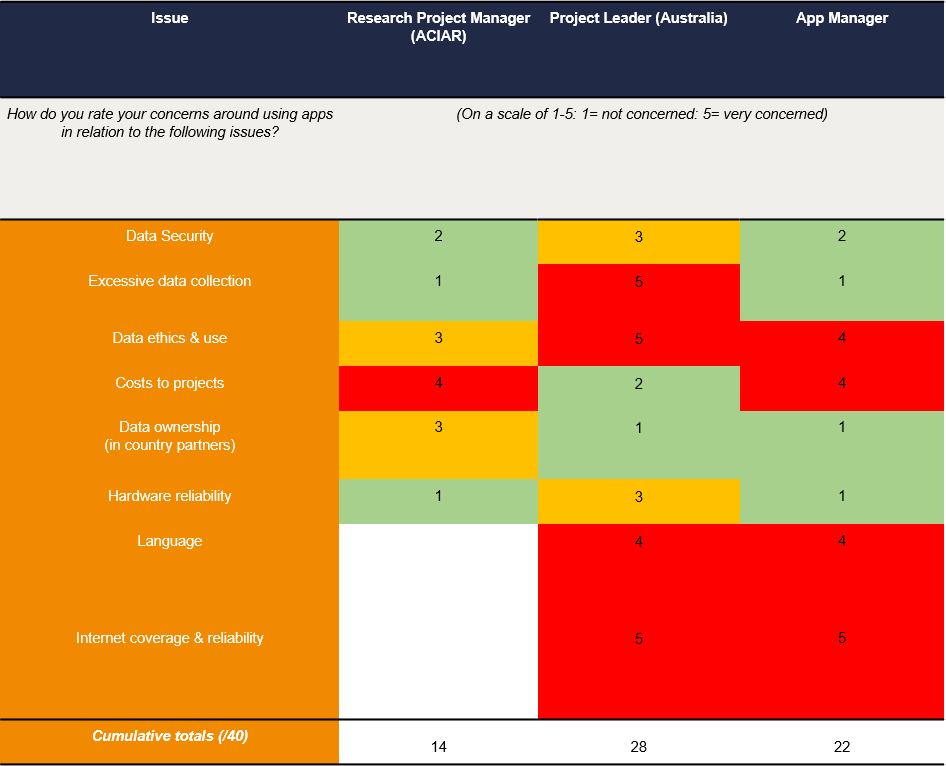
MAD Activities
Two CommCare applications for mobile data collection were developed for the MyRice project:
- One application with 3 short forms to capture short, high level interviews with farmers (developed with 2.5 months lead time), and
- One application for in-depth (1.5 hour) household survey interviews (developed with 6 months lead time).
Designing and building the apps
The MyRice project received three training workshops totalling 12.5 days (the most of all MAD series projects). The team also received additional remote support from Oikoi during the building phase. Training in CommCare provided to the project staff was comprehensive and began with a 2-day introduction in Myanmar. This was followed by two 5-day sessions at IRRI headquarters in the Philippines.
Farmer interview application
MAD planning for the farmer interview data sheet was integrated into a strategic planning meeting for the MyRice project's extension year. Leadership, researchers and field supervisors were all present at the meeting. The paper design for this data sheet was expanded on and altered based on input from these attendees. At the time, the sheet was converted into a simple digital architecture with assistance from the AgImpact instructor. There were relatively few changes to this design or the timeline after that planning meeting.
Household survey application
The household survey application was similar to the project’s paper baseline questionnaire. While the paper design was well established and field tested, it was complex as an application (consisting of 15 forms). Reproducing the structure in CommCare required support from Oikoi during the second training session. Building duties for this application were shared between 4 of the 8 IRRI CommCare trainees, who formed a CommCare community of practice ("A Ladies"). The 15 survey forms were divided between the participants and the women met every two weeks over a 5-month period to engage in application building and to test and provide feedback on each other's work. Each subject within the extended household survey was isolated into its own form in the application. This allowed for a potentially fragmented interview process in case surveys were interrupted by the participating farmer's urgent tasks. Isolation of survey segments into individual forms also reduced the risk of data loss. A checklist was built into the app so that enumerators could review which forms had been completed and warning messages were built in to prevent duplication of forms. Calculations and smallholder feedback (in the form of farm inputs and production summaries) were added to the application during the final training. After building, some refinements to the questionnaire were made later with input from Myanmar field staff.
Testing the apps
A mixture of desktop and interview style testing was shared between researchers and the field team for both applications. Several rounds of testing were required during the household survey application build. This was because the questionnaire was ‘logic heavy’, with different responses resulting in quite different behaviour in the forms. Formal testing of both applications was conducted by Department of Agriculture (DoA) over two days. This involved supervised field testing by DoA Myanmar staff who acted as enumerators. Eight DoA staff participated in the farmer data sheet interviews and fifteen participated in the household survey. During the enumerator training, researchers refined the apps based on daily enumerator feedback in the evenings. Due to the complexity of the household survey app, a lot of support was required close to the deployment date during these last-minute changes to get the application error-proof before the deadline.
Deploying and monitoring
Smallholder data previously collected in the MyRice baseline surveys was imported into CommCare to eliminate the need for farmer registration in the new household survey application. IRRI scientists accompanied the enumerators to the field during app deployment. Data was downloaded each afternoon and light analysis and quality checks were performed. A formal debriefing was held with enumerators each evening. The researchers travelled with a mobile hotspot to ensure an internet connection was available for these checks. Where data issues could not be reconciled on the spot, enumerators were sent back to check with the respondents before the team moved to the next village. When assistant scientist in the field Su Su San had questions about the data format, specialists at IRRI in the Philippines were able to download data from the server and assist her with rapid analysis. Some of the data updates during this process were made on the server using CommCare's form editing feature. However, as some forms in the application were more complex, they were not compatible with the editing feature. In those cases alterations were made in an exported copy of the data.
Benefits & Challenges
Benefits
MAD implementation was well received by IRRI as an institution, leading to an improved capacity for MAD being developed at the organisation. The researchers at IRRI were impressed with CommCare features compared to other MAD platforms they had used. As a result of the MAD implementation in MyRice, some IRRI staff now have the skills to develop any application they require. By building new applications based on the structure of existing ones, IRRI staff were subsequently able to have sophisticated surveys for other projects field-ready in a much shorter time frame. Through this MAD implementation in MyRice, IRRI was beginning to establish a consistent data format across multiple projects – an aim outlined by Dr Singleton at the commencement of the MAD activities.
The researchers estimated that using the MAD household survey saved 1.25 hours per interview when compared to the paper-based questionnaire. This amounted to half the time taken to complete the paper survey and represented a total time saving of 39 working days. Data collection was completed much earlier than expected. The enumerators and farmers who had participated in the baseline were very grateful for the shorter interview times and researchers noted less fatigue than usual in the field. Department of Agriculture staff were pleased to carry tablets instead of boxes of paper and generally found the app made their job easier. This was especially so where skip logic was automated in the forms. The field staff stated that they wished the tablets had been used throughout the project. Farmers appreciated the instant feedback regarding their seasonal profits and the agricultural scientists found the calculations greatly reduced the workload of analysis. A newer version of the household survey was subsequently created that included additional calculations that were missed the first time.
Challenges
Challenges to MAD implementation in MyRice included the time taken for capacity building, testing advanced features, issues in designing and form editing, adding qualitative observations and wider MAD implementation at IRRI. Significant work was involved in up-skilling IRRI staff in CommCare application building. Over time, however, the team's support requirements reduced and at least two scientists at IRRI could now be considered experts in CommCare application building. A total of 56 combined days were spent by the two researchers most involved in the development of the farmer data sheet and household survey. Despite the challenges they continued to build capacity over the 9-month period of MAD implementation.
Twenty-six feedback responses were recorded from the MyRice research team during MAD adoption in the SRA. These indicated that the team found planning to be ‘Easy’ to ‘Normal’. While the majority of responses marked Training and Building ‘Easy’ or ‘Normal’, almost one third of relevant responses recorded these phases as being ‘Difficult’ (Figure 8). Testing and Deployment phases were mostly recorded as being ‘Easy’ by staff and the two responses reporting for Data Monitoring & Management marked it as ‘Normal’.
By pushing boundaries and using the most sophisticated coding available, the team frequently hit the limits of CommCare functionality and identified bugs that needed to be resolved by Dimagi staff. They twice underestimated the degree of testing and error handling required for such logically complex applications and had stressful periods of hard work prior to launch. While the app building community (“A-ladies”) intend to hold institutional workshops to introduce their peers to CommCare, there is a challenge in transferring their skills to other IRRI staff. All of these women wish to pursue their original careers (they have full-time workloads as scientists) as much as possible rather than build applications for other projects or become trainers.
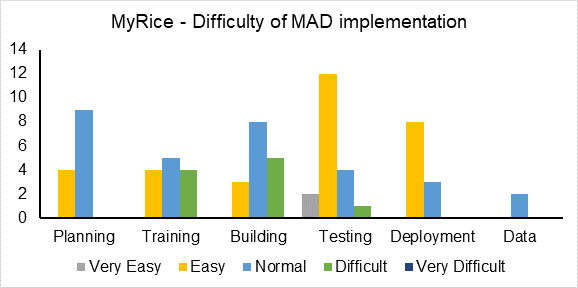
Financial & Time Costs
The financial costs involved for MAD implementation was not made available by the Myanmar Rice research team. The total number of Oikoi support days provided to the project was 34 (see Table below). An additional 5.2 days logged for travel and logistics. This was the highest number of support days for a MAD project and reflects additional training, the complexity of the apps that were created and the longer time required for capacity building. Project staff spent a total of 56 days adopting MAD applications. Most of this time was spent in training (15 days) building (18 days) and testing (11 days).
